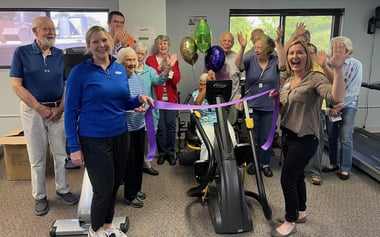 Westminster Village of Terre Haute was thrilled to participate in the first year of Pump it for Parkinson’s last year! My residents enjoyed the program, learning about the benefits of exercise for those fighting back against Parkinson’s Disease, as well as contributing to a nationwide goal of achieving one million steps along with thousands of other seniors in communities across the country. They also enjoyed the excitement of potentially winning a new NuStep T6 for our fitness center. Residents commented that even if we did not win the machine, at least we aided in the message regarding Parkinson’s Disease being delivered. Once the BIG Day came to an end and our community learned that we won the drawing for the grand prize, our entire community was thrilled and in shock! Now, let’s discuss three features that my residents have been LOVING about their new NuStep T6 recumbent trainer:
Westminster Village of Terre Haute was thrilled to participate in the first year of Pump it for Parkinson’s last year! My residents enjoyed the program, learning about the benefits of exercise for those fighting back against Parkinson’s Disease, as well as contributing to a nationwide goal of achieving one million steps along with thousands of other seniors in communities across the country. They also enjoyed the excitement of potentially winning a new NuStep T6 for our fitness center. Residents commented that even if we did not win the machine, at least we aided in the message regarding Parkinson’s Disease being delivered. Once the BIG Day came to an end and our community learned that we won the drawing for the grand prize, our entire community was thrilled and in shock! Now, let’s discuss three features that my residents have been LOVING about their new NuStep T6 recumbent trainer:
Seamless Setup – Numerous residents must only be instructed on how to utilize the NuStep T6 once. Residents enjoy the idea that they can sit within the machine and simply begin to move for the machine to respond to them beginning the activity. The fact that their personalized seat number setting is displayed on the screen allows residents to easily adjust as needed to fit their needs.
Walking Trails – Once residents are set and ready to go with their personalized settings, many utilize the touch screen to select the first dialogue box titled “Walking Trails”. This dialogue box is by far the most popular selection allowing participants to “travel” during exercise. Residents enjoy having me by their side as they travel through the various environments to discuss the architecture within each environment. Each trail supports users in making physical activity more engaging and less monotonous through their work out!
Workout Summary – At the completion of each workout session, the machine displays all the hard work completed for review. Residents are keen to share their workout summaries with me as they complete their workout and ask questions regarding parameters that are tracked that they may not be familiar with. This feature is a great segway into explaining the purpose of exercise utilizing the NuStep T6 while the residents learn something new regarding their physical activity capabilities and progression. I have had a few residents track their workout summaries within their personal journals so they can track their progress and share it with me on a weekly basis.
I highly recommend the NuStep T6 for senior living fitness centers both from the satisfaction in which I see my residents enjoying it as well as my vantage point as a degreed fitness professional and the motivation and engagement I see it supporting my participants in being physically active.
Which of the three categories do you think the residents within your community would enjoy the most? We are pumped to contribute our steps this World Parkinson’s Day on our new NuStep T6!
Follow us at Pump it for Parkinson's on Facebook as we strive for 10,000,000 steps to represent the 10,000,000 people worldwide living with Parkinson's Disease on World Parkinson's Day, Thursday, April 11!

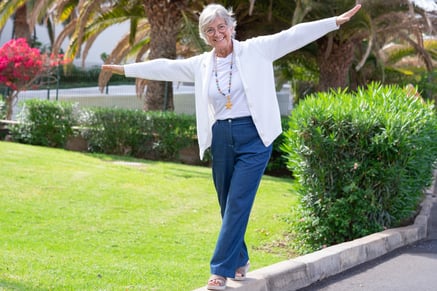 What is great about practicing balance is there are multiple ways to do so without breaking the bank. In
What is great about practicing balance is there are multiple ways to do so without breaking the bank. In 
.jpg?width=485&height=372&name=Nustep%20(1).jpg) The NuStep is a great multifunctional piece of equipment. Did you know the NuStep can be used for more than just building endurance? You can build strength, cardio, AND endurance depending how you use it. This is what makes the
The NuStep is a great multifunctional piece of equipment. Did you know the NuStep can be used for more than just building endurance? You can build strength, cardio, AND endurance depending how you use it. This is what makes the 
.png?width=343&height=287&name=PUMP%20IT%20FOR%20PARKINSONS%20SOCIAL%20(11).png) When designing a senior living fitness center, there are many factors that aid in the decision process when choosing equipment for our clients and their residents. We want to incorporate equipment that is cost effective, easy to move, applicable and safe for many individuals, and of course enjoyable. Here are five reasons why the
When designing a senior living fitness center, there are many factors that aid in the decision process when choosing equipment for our clients and their residents. We want to incorporate equipment that is cost effective, easy to move, applicable and safe for many individuals, and of course enjoyable. Here are five reasons why the .jpg?width=335&name=GettyImages-526312285%20(1).jpg) pickleball.
pickleball.
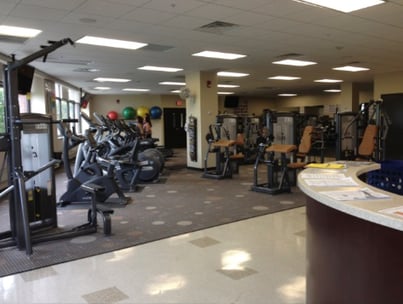 This has been the year of design and consulting work for senior living clients who are renovating or building new fitness centers. I think I could give you the dimensions of a NuStep T4r model in my sleep (they are 60 x 27 x 24 inches, by the way). It truly is exciting to see the industry dedicating resources to well-designed fitness spaces to support quality programs and services for residents.
This has been the year of design and consulting work for senior living clients who are renovating or building new fitness centers. I think I could give you the dimensions of a NuStep T4r model in my sleep (they are 60 x 27 x 24 inches, by the way). It truly is exciting to see the industry dedicating resources to well-designed fitness spaces to support quality programs and services for residents.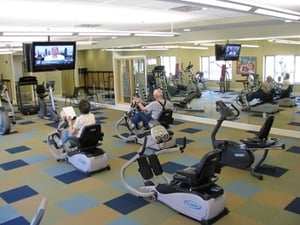 Televisions and entertainment: Determine whether you will pursue wall-mount televisions or the integrated console option on the cardio machines. With some equipment like NuSteps and rowers not having the integrated TV option, you will want a wall-mount TV somewhere in your facility. With wall-mount TVs you’ll have to navigate the channel wars for the lifelong battle between Fox News, CNN, and MSNBC, which individuals have VERY strong preferences for—imagine that! Consider an FM tuner option with headphones if needed, but we generally see residents politely following the first-come, first-served rule.
Televisions and entertainment: Determine whether you will pursue wall-mount televisions or the integrated console option on the cardio machines. With some equipment like NuSteps and rowers not having the integrated TV option, you will want a wall-mount TV somewhere in your facility. With wall-mount TVs you’ll have to navigate the channel wars for the lifelong battle between Fox News, CNN, and MSNBC, which individuals have VERY strong preferences for—imagine that! Consider an FM tuner option with headphones if needed, but we generally see residents politely following the first-come, first-served rule.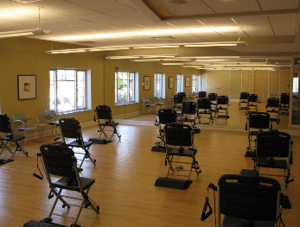 Exercise chairs: We are big fans of the
Exercise chairs: We are big fans of the 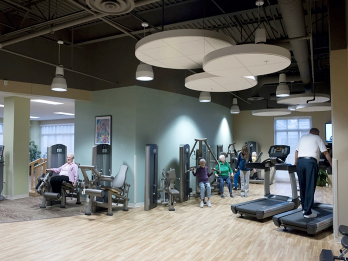 Picture this: You are 78 years old touring a senior living community with the marketing and sales coordinator. They take you to the ground floor or basement of the building and they flip on the lights of the uninhabited fitness center. It has painted cinderblock walls, fluorescent lights, no windows, and a hodgepodge of equipment. It feels deserted and you wonder how active the community is.
Picture this: You are 78 years old touring a senior living community with the marketing and sales coordinator. They take you to the ground floor or basement of the building and they flip on the lights of the uninhabited fitness center. It has painted cinderblock walls, fluorescent lights, no windows, and a hodgepodge of equipment. It feels deserted and you wonder how active the community is.
.jpg?width=300&name=GettyImages-816941230%20(1).jpg) A member recently asked me how they can stay active while they are traveling or otherwise unable to make it to the gym. Here I’ll discuss several different topics to address the issue, taking into consideration space, time, equipment, and the individual’s goals. Our members’ ages are between 67 and 100, so the goals will vary depending on functional ability.
A member recently asked me how they can stay active while they are traveling or otherwise unable to make it to the gym. Here I’ll discuss several different topics to address the issue, taking into consideration space, time, equipment, and the individual’s goals. Our members’ ages are between 67 and 100, so the goals will vary depending on functional ability.
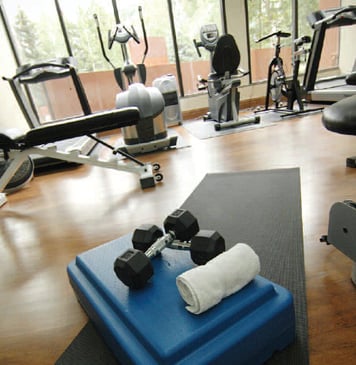 Clients regularly ask me whether we have any recommendations or contacts for certain exercise equipment, or if we have any successful models in place for collaborating with rehab departments or cafeteria vendors. The bulk of our contacts in the world of fitness are with current clients where we have our professional staff on the ground managing their fitness program, or with consulting clients where we are providing support and resources to enhance their existing program. However, we also have a large network of industry contacts that we partner with, allowing us to (1) provide the quality service we do to our clients and (2) support other businesses outside of a client setting.
Clients regularly ask me whether we have any recommendations or contacts for certain exercise equipment, or if we have any successful models in place for collaborating with rehab departments or cafeteria vendors. The bulk of our contacts in the world of fitness are with current clients where we have our professional staff on the ground managing their fitness program, or with consulting clients where we are providing support and resources to enhance their existing program. However, we also have a large network of industry contacts that we partner with, allowing us to (1) provide the quality service we do to our clients and (2) support other businesses outside of a client setting.
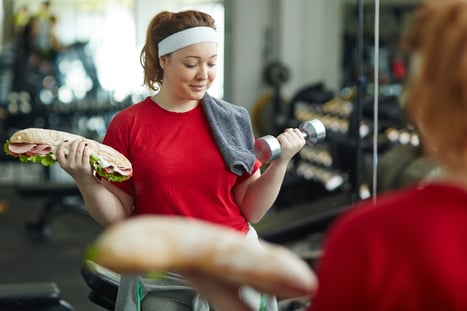 Precontemplation
Precontemplation